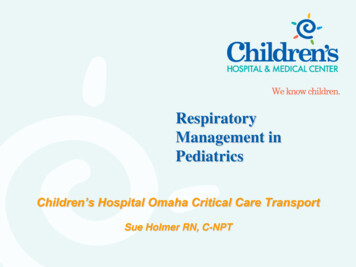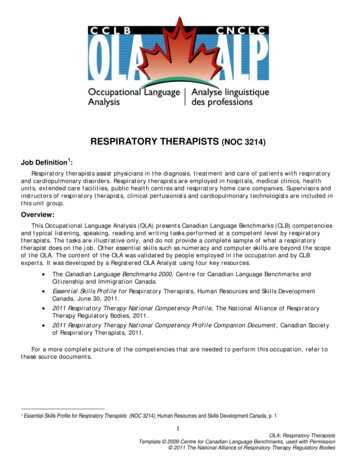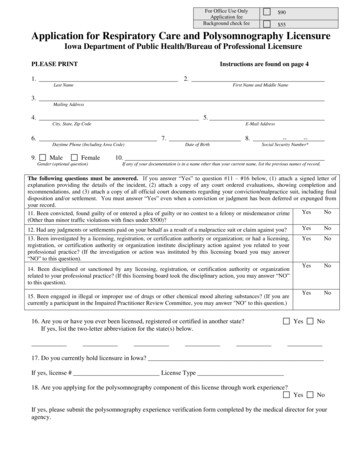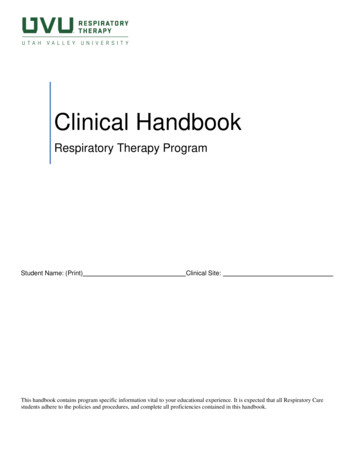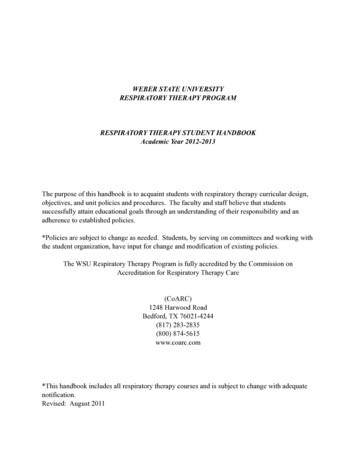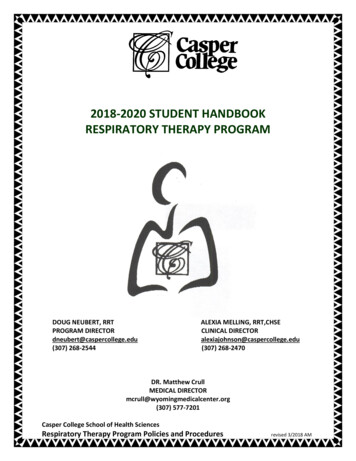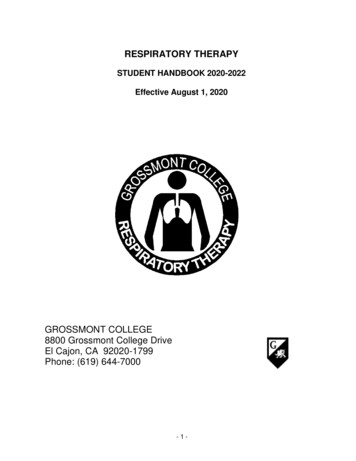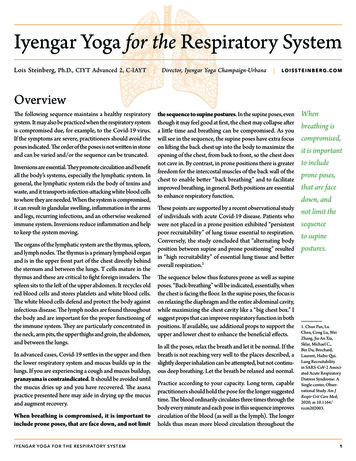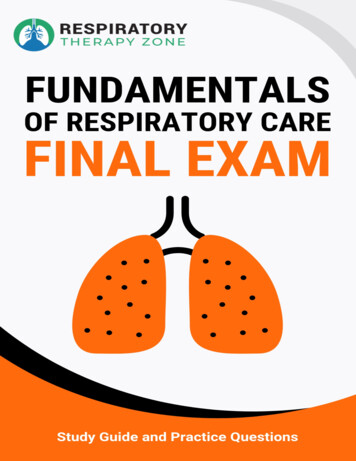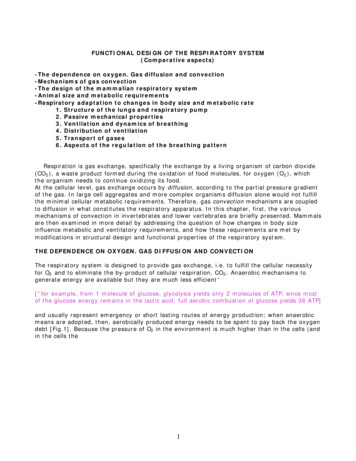
Transcription
FUNCTIONAL DESIGN OF THE RESPIRATORY SYSTEM(Comparative aspects)-The dependence on oxygen. Gas diffusion and convection-Mechanisms of gas convection-The design of the mammalian respiratory system-Animal size and metabolic requirements-Respiratory adaptation to changes in body size and metabolic rate1. Structure of the lungs and respiratory pump2. Passive mechanical properties3. Ventilation and dynamics of breathing4. Distribution of ventilation5. Transport of gases6. Aspects of the regulation of the breathing patternRespiration is gas exchange, specifically the exchange by a living organism of carbon dioxide(CO2 ), a waste product formed during the oxidation of food molecules, for oxygen (O2 ), whichthe organism needs to continue oxidizing its food.At the cellular level, gas exchange occurs by diffusion, according to the partial pressure gradientof the gas. In large cell aggregates and more complex organisms diffusion alone would not fulfillthe minimal cellular metabolic requirements. Therefore, gas convection mechanisms are coupledto diffusion in what constitutes the respiratory apparatus. In this chapter, first, the variousmechanisms of convection in invertebrates and lower vertebrates are briefly presented. Mammalsare then examined in more detail by addressing the question of how changes in body sizeinfluence metabolic and ventilatory requirements, and how these requirements are met bymodifications in structural design and functional properties of the respiratory system.THE DEPENDENCE ON OXYGEN. GAS DIFFUSION AND CONVECTIONThe respiratory system is designed to provide gas exchange, i.e. to fulfill the cellular necessityfor O2 and to eliminate the by-product of cellular respiration, CO2 . Anaerobic mechanisms togenerate energy are available but they are much less efficient*[*for example, from 1 molecule of glucose, glycolysis yields only 2 molecules of ATP, since mostof the glucose energy remains in the lactic acid; full aerobic combustion of glucose yields 36 ATP]and usually represent emergency or short lasting routes of energy production; when anaerobicmeans are adopted, then, aerobically produced energy needs to be spent to pay back the oxygendebt [Fig.1]. Because the pressure of O2 in the environment is much higher than in the cells (andin the cells the1
Fig.1.A sudden onset of muscle exercise (top record) is not accompanied by a parallelincrease in O2 consumption ( VO2 ). Rather, VO 2 increases gradually. The differencebetween the energy immediately produced and that generated by the aerobicprocesses (dashed area) is an aerobic energy deficit, or ‘O 2 debt’. At the end ofexercise, VO 2 remains higher, because aerobic processes are regenerating the energyused anaerobically at the onset of exercise (‘payment back of the O2 debt’).pressure of CO2 is much higher than in the environment, where it is almost zero) we shouldexpect a continuous diffusion of O2 into, and of CO2 out of, the cells. This is indeed the case, anddiffusion represents the basic physical process governing respiration [Fig.2]. However, thenumber of molecules that can diffuse in and out per unit time is inversely proportional to theFig.2.Diffusion gradients of O2 and CO2 between mitochondria and environment2
distance between the organs where cellular respiration takes place (mitochondria) and theenvironment, and the time of diffusion increases with the square of the distance. Hence, only invery simple organisms can diffusion alone provide the minimum amount of gas exchange perunit time (conveniently expressed by O2 consumption, VO2 , or CO2 production, VCO2 ) requiredfor cell survival. In more complex aggregates gas exchange would take too long to fulfil themetabolic needs. Nature has circumvented this limitation by coupling the diffusion process toconvection, whereby the environmental air is effectively brought into contact with all the cells ofthe organism via finely controlled structures. The way convection operates varies remarkablythroughout the animal kingdom, and the design of the convection system is intimately related toboth the metabolic needs of the organism and other non-respiratory functions of the respiratorystructures. In vertebrates, two systems of pipes with their respective pumps convey gases to andfrom the cells, the respiratory system, which operates with a gaseous or liquid medium, and thecardiovascular system, in which blood represents the convection medium. They are coupledtogether at the pulmonary (or gill) gas exchange area where gas transfer depends on diffusion,similar to what occurs at the cellular level [Fig.3].Fig. 3. Schematic representation of the physical (top) and structural (center andbottom) basis for gas transport between environment and cell in vertebrates, whetherthe breathing medium is water or air.MECHANISMS OF GAS CONVECTIONIn insects, both diffusion and convection are enhanced by the presence of a complex systemsof tubes, the tracheolae, connecting the body surface to the innermost tissues. In fact, in somecases the tracheolae penetrate the cells, and blood circulation is therefore redundant, at least for3
the purposes of gas convection. In others, tracheolae deliver O2 to the hemolymph, where it isexchanged by diffusion, and the hemolymph delivers to the cells. The quantity of air circulated(Ventilation, VE) is regulated via spiracles [Fig.4], according to control programs whichcompromise between the metabolicFig.4. Frequency of spiracles opening in a flea (Xenopsylla cheopis) at 20-22oC,exposed to hypoxic or hyperoxic environments. (Modified from Dejours, Principles ofRespiratory Physiology, Elsevier, 1975, based on data from Wigglesworth, Proc.RoyalSoc.B, 118:397-419, 1935).necessities of the insect and the problem of water loss which would accompany excessiveexposure of inner body surfaces.Enormous increases in gas exchange area can be achieved not only by inward foldings, as inthe case of the insects tracheolae, but also by outward protrusions, as in the case of the multiplelamellae of fish gills.In fish, the large diffusion area of the gills is placed along the unidirectional stream of waterentering the mouth and exiting via the operculum, behind the gill filaments. The unidirectionalflow is usually helped by two aspiration-compression pumps [Fig.5],4
Fig.5. Schema of gas convection in fishin the oral cavity and in the opercular cavity, which act in coordination with the opening andclosure of mouth and operculum. This design of unidirectional water flow across the gills from thefront to the sides has the potential for providing sufficient water convection simply by swimmingforward with the mouth open. Indeed, in some fishes, gill ventilation depends more onlocomotion than on active pumping, and in these cases (e.g. tuna fish) continuous forwardswimming becomes a fundamental necessity for VE. From an energetic view point, an optimalsolution is that of Remora remora. This fish, by attaching itself to the body of a shark, gets notonly a free ride and the leftovers of the shark's meals but, by keeping its mouth open, also a freeVE. The inhibition of pump activity, in these cases, would be mediated by receptors functionallyequivalent to the vagal stretch receptors of the mammalian lung. In addition, the unidirectionalflow design offers an opportunity for extremely efficient gas exchange [Fig.6]. In fact, in thelamellae, the anatomical arrangement is such that the direction of blood flow is opposite to5
Fig.6. Simplified models of gas exchange. At top, air is conveyed and mixed in achamber, where the partial pressure of O 2 (PO2) is less than inspired (PIO2 ). The PO2 of‘arterialised’ blood leaving the chamber at best (i.e. no diffusion limitation) will be asin the chamber, and always less than PIO2. In the concurrent exchange system(middle) the partial pressures of the air and the blood leaving the exchange area willbe the same. In the countercurrent exchange system (bottom) the PO2 of thearterialised blood can approach the inspired.(Modified from Dejours, Principles of Respiratory Physiology, Elsevier, 1975)6
that of the water (counter-current pattern). Hence, the venous blood reaching the gill capillariesis meeting water with progressively higher PO2 , and the arterialized blood leaving the gillcapillaries can have a PO2 higher than that of the water leaving the gas exchange area. Thiswould never be the case with the back-and-forth design of the mammalian VE, whereby thevalue of arterial PO2 can approach but never exceed alveolar or expired PO2 .Gas convection in some amphibians is a clear example of positive pressure ventilation. Theupward lifting of the mouth floor generates a positive pressure which forces air into the lungs[Fig.7]. This mechanism is in many respects simpler thanFig.7. Schema of gas convection in frogsthe double pump arrangement of the fish, and is only aided by the valve action of the nares andthe glottis. As far as the mechanics of lung inflation, positive pressure 'buccal' ventilation is moreeffic ient than the mammalian suction pump since chest expansion of the lung by positivepressure eliminates the inefficiency caused by chest distortion. On the other hand, the mouth VEof the amphibians has obvious disadvantages. The inflation volume is limited by the size of themouth, and VE in amphibians has to compromise with the non-respiratory functions of the upperairways more than it does in reptiles, birds and mammals.Turtles were first thought to breathe with a mechanism similar to that of the amphibians, butit is now clear that they operate by negative pressure ventilation as in other reptiles.Contraction of chest wall muscles, laterally located in the turtle, more circularly placed in lizardsand snakes, lowers the pressure inside an air sac generating inspiratory flow [Fig.8]. The sac7
Fig.8. Schema of gas convection in snakesis larger than the functional lung, and in snakes it can be almost as long as the whole body,although the gas exchange portion is only in its proximal region. The reptilian breathing cycle ischaracterized first by active expiration, then by active inspiration, terminating with relaxationagainst the closed glottis at a lung volume above the passive resting volume, hence, withpositive airway pressure between breaths [Fig.9]. Inspired air is therefore sucked through thegas exchange region and retained for a period in the sac.8
Fig.9. One breathing cycle in the garter snake. The respiratory pause between breathsis usually at a lung volume above the resting volume of the respiratory system, withpositive pressure in the airways. Hence, the beginning of the breathing cycle, at theopening of the larynx (dashed vertical line at left), is accompanied by expiratory flowand a decrease in lung volume. Inspiration begins only when airway pressure becomessub-atmospheric.Gas from the sac is forced through the same gas exchange region in the opposite directionduring expiration.The same idea in design, but more sophisticated, is found in the avian9
respiratory system. In birds, numerous large avascular sacs, some located anteriorly and othersposteriorly, are the compliant structures expanding and compressing with the phases of thebreathing cycle, whereas the lungs are small, almost rigid organs connected to the vertebral sideof the ribs [Fig.10].Fig.10. Schema of gas convection in birds.Although both anterior and posterior sacs are connected to the lungs, the inhaled air headsalmost entirely to the posterior sacs via the mesobronchus. During inspiration the anterior sacsexpand too, but they receive mostly air from the lungs. During the following expiration, thepreviously inhaled air moves into the lung, while the air stored in the anterior sacs is exhaled.Therefore, the bolus of air inspired takes two full cycles to be exhaled, going from the tracheaand the mesobronchus to the posterior sacs during the first inspiration, to the gas exchange areain the first expiration, to the anterior sacs in the second inspiration, and finally out with theexpiratory phase of the second cycle. This flow pattern, the direction of which is determined byregional pressure differences rather than anatomic valves, guarantees a continuousunidirectional flow through the lung irrespective of the phase of the breathing cycle. In addition,air and blood flows in the lung are arranged according to a cross-current pattern, which,although not as efficient as the true counter-current arrangement, is still a better gas exchangerthan the VE-perfusion matching of the mammalian lung. The result of this sophisticatedconvection system is that the blood can load more O2 , and does so from an exchange organ withan higher O2 concentration than present in the mammalian alveoli. The ultimate test of efficiencymay be represented by the ability to survive and perform in hypoxia, and the results areunequivocal. When a mammal and a bird of comparable size, metabolic rates and blood O2affinity are exposed to severe hypoxia, the former lays down panting while the latter is stillflying. Some birds are known to migrate flying high above the Himalayas, at altitudes where nomammal would be able to survive.THE DESIGN OF THE MAMMALIAN RESPIRATORY SYSTEMQuite differently from the avian model, the mammalian solution to the gas exchange problemis a back and forth convection of air through the same system of conducting pipes, with thepulmonary gas exchange area located at the terminal end of the conducting airways. Themammalian tidal respiration implies that in the alveoli PO2 and PCO2 will be, respectively, lower10
and higher than in the environment [Fig.11]. Because the alveoli are the terminal structures, theblood leaving the pulmonary11
12
Fig. 11. Mammalian breathing. Changes in lung volume (spirogram), flow(pneumotachogram) and intra-airways pressure during a breathing cycle. During thecycle, alveolar pressure of O2 and CO2 (PAO 2, PACO2) oscillate around a mean value,with a profile that depends on the characteristics of the breathing pattern andmetabolic rate. At the beginning of inspiration, PAO2 drops and PACO2 increasesbecause the inspired air (of which, at sea level, PO2 is about 150 and PCO2 around 0) isfilling the dead space. Gas arterial values follow closely the corresponding alveolarvalues.capillaries cannot be as well arterialized as with the flow-through system of the avian model. Inaddition, having a common pathway for inspiration and expiration means that part of the inhaledair will not participate to gas exchange*,[*The larger the volume of the conductive airways (also called anatomical dead space, VD) thesmaller the fraction of tidal volume (VT) reaching the gas exchange area, also called alveolarvolume (VA). In many adult mammals during resting breathing VD approximates one-third VT,hence, alveolar ventilation VA is about two thirds of VE]reducing the gas exchange efficiency of VE in comparison with the air and blood flowarrangements of fish and birds. On the other hand, that part of the body space which in reptilesand birds is occupied by the sacs in mammals can be used by the lung itself; this results in a gasexchange area which is very large relative to body mass and fully protected inside the body.As in reptiles and birds, the mammalian ventilatory pump operates by a negative pressuresuction mechanism. The major difference is the separation of the visceral cavity into a thoracicand an abdominal compartment by a muscular layer, the diaphragm. Contraction of this musclelowers pleural pressure, which results in lung expansion (caused by the rise in transpulmonarypressure), together with a tendency for the rib cage to collapse (caused by the negative pressuredifference between inside and outside of the rib cage) [Fig.12]. To what extent, duringdiaphragmatic contraction, the inward13
.Fig.12. Factors determining the motion of the rib cage and abdomen duringinspiration. The mechanical arrangement of the mammalian respiratory system is suchthat, when the diaphragm contracts, the abdominal component of the transdiaphragmatic pressure (Pdi) expands the abdomen (ab), while the pleural component(Ppl) tends to suck the rib cage inward.movement of the rib cage (i.e. distortion of the chest wall) actually occurs depends on a numberof factors which include the relative compliance of lung and chest wall and the action of theextra-diaphragmatic muscles. Therefore, the respiratory pump in mammals is prone to a greatdeal of deformation, and the intercostal muscles have the important function of stabilizing the ribcage against the distorting action of the diaphragm. A dramatic example of this is offered bythose patients with a complete lesion of the upper spinal cord. These patients can breathebecause the motor roots of the phrenic nerve, innervating the diaphragm, emerge from thecervical portion of the spine above the lesion. However, thoracic and abdominal muscles, inaddition to limb muscles, are paralysed (tetraplegic patients). In these cases, the rib cagedistorts during inspiration because the intercostal muscles are not offsetting the action of thepleural pressure on the chest [Fig.13].14
Fig.13. Chest wall motion in tetraplegics (at right) compared to a normal subject (atleft), during resting breathing in supine position. During inspiration the diaphragmdistorts the chest wall by pulling inward the rib cage, a phenomenon which in normalsubject is compensated by the action of the extra-diaphragmatic muscles.On the one hand, having the main inspiratory muscle (the diaphragm) facing only one side ofthe thorax may seem poor mechanical design since a substantial fraction of diaphragmatic forceis dissipated not in ventilating the lungs but in distorting the pump itself. On the other hand, thecomplete separation of the coelomic cavity into two compartments decreases the disturbingeffects of postural changes, locomotory activities and variations in abdominal pressure on thedistribution of pulmonary VE.ANIMAL SIZE AND METABOLIC REQUIREMENTS.About 4300 species of mammals are presently known to exist, covering an extremely largerange in body size, from the shrew weighing a few grams to the African elephant weighingseveral tons; marine mammals can have even larger weights, and the Blue whale can reach 100120 tons. Mammals are homeotherms, and maintain body temperature within a rather narrowrange, 36-39o C. Some exceptions do occur, as in monotremes (platypus and echidna, with bodytemperature around 32-33o C), special conditions and habitats (like during hibernation, estivationand torpor), and the newborns of some species.The constancy in body temperature among mammals, despite the huge differences in size,15
Allometric relationships of respiratory variablesAllometric analysis is a special case of normalization by body weight (BW), in the process ofcomparing subjects of different body size within the same species, e.g. during growth, or sameage animals of different species. A given structural or functional parameter Y is examinedaccording to the function Y a . BWb . The log-transformed version of this function, log Y log a b. log BW, is particularly useful. When the slope b, which is the exponent of the originalexponential function, equals unity, the variable Y increases in direct proportion to animal bodyweight, the proportionality factor being a. Slopes higher or smaller than unity indicate that thevariable under consideration increases, respectively, disproportionately more or less with theincrease in body weight.The following is a list of allometric exponents for some parameters pertinent to respiratoryphysiology of adult mammals:Yboxygen consumption0.75lung weight (or mass)1.0pulmonary gas exchange surface area0.75pulmonary ventilation0.75tidal volume1.0breathing rate-0.25respiratory system compliance1.0respiratory system resistance-0.75suggests that either thermodispersion, or thermoproduction, or both, must vary among species.Thermodispersion is mostly determined by body surface. Heat production is determined by themetabolic activities of the cells and hence is proportional to body mass. If, for simplicity, wethink of an animal as a sphere, because sphere surface is proportional to the square of lengthand sphere volume is proportional to the third power of length, it follows that the larger theanimal body the smaller its surface-to-volume ratio. Hence, large animals should be muchwarmer than smaller animals; the fact that this is not so is because the metabolic activity of thecells of large animals is not as pronounced as it is in the smaller species. Indeed, it has longbeen recognized that, although the VO2 of the whole organism increases with the size of thespecies, after normalization by the animal's weight (VO2 /kg) the opposite is true: VO2 /kgprogressively decreases with the increase in animal's weight [Fig.14, bottom]. In other words, ifwe had 1 g samples of "average" flesh from a 100 g rat, 20 kg dog, 70 kg man and a 516
Fig.14. The function relating a species resting oxygen consumption (VO 2) to its bodymass ( "mouse-to-elephant" curve) indicates a progressive reduction in VO2/kg (at17
bottom) as species get bigger. This means that when VO2 is plotted against body mass(at top) in double log-scale the slope of the function is less than unity. In fact, theallometric exponent of VO 2 is about 0.75, which is less than 1, yet above the value(0.66) expected by geometric similarity. The latter exponent (0.66) is what observedfor different size animals within the same species.-ton elephant we would find that VO2 progressively decreases from the rat's sample, to thedog's, man's and elephant's. A similar finding would occur if we were comparing samples fromdifferent size animals within the same species. In fact, it turns out that VO2 within a species isproportional to the 2/3 power of body weight (BW 0.66 ), which is the exponent to be expectedaccording to the surface-volume argument presented above. VO2 among species, on the otherhand, scales to BW 0.75, which is clearly below unity, yet significantly above the expected 0.66[Fig.14, top]. The reason for this discrepancy is not fully understood, and may relate to theexistence of a systematic variation from the simplistic sphere analogy (possibly related to theinfluence of gravity in shaping the animal's body) and in differences among mechanisms of heatdissipation.RESPIRATORY ADAPTATION TO CHANGES IN BODY SIZEAND METABOLIC RATE.The values of the partial pressures of oxygen and carbon dioxide (PO2 and PCO2 ) of thealveolar gas and arterial blood essentially reflect the ratio between what is used (O2 ) or produced(CO2 ) and what is ventilated, respectively, in or out the lungs. Both PO2 and PCO2 are verysimilar among species, which may not be surprising since mammalian functions have an optimaloperational acid-base range, just as they have an optimal temperature range. Given that VO2 /kgis not constant among mammals of different size, the similarity in PO2 and PCO2 implies that alsothe ventilatory apparatus must vary among species, either in structure, function, or both, toaccommodate differences in ventilation.Indeed, size-related modifications in the mammalian design of the respiratory system occurboth at the structural and functional level to accommodate the different metabolic needs, andwill be examined systematically in the following sections A-F.1. Structure of the lungs and respiratory pump. Comparison of adult mammalian speciesover a 104 range in size have indicated that the mass of the lung is a fixed proportion of the totalanimal's weight, approximately 1%. Also the amount of air present in the lung, at apredetermined transpulmonary pressure, is directly proportional to body and lung mass. Thisshould imply that lung compliance (change in volume per unitary change in transpulmonarypressure), whether compared per unit of lung tissue or per BW, is an interspecies constant.Direct measurements of lung compliance show that this is the case; in addition, the shape of thepressure-volume deflation curve, and derived mathematical parameters describing thetranspulmonary pressures during lung deflation, vary little among species [Fig.15].18
Fig.15. Pressure-volume (P-V) curve of the lungs during deflation from maximalvolume (plateau) in several mammals. The shape of the P-V curve is remarkablysimilar, even if lung volumes differ from a few ml in mice and rats to 800 liters in thewhale. The P-V deflation constant K (cm H 2O-1, obtained by exponential fitting of thecurve), which is an index of the volume-specific stiffness of the lungs, is essentiallyindependent of body mass. The only exception may be the cat, with unusually highspecific compliance.(Modified from Schroter, Respir.Physiol.42:101-107,1980).The gross aspects of the internal architecture of the lungs are similar among mammals. Thevolume of the conducting airways, which contribute to the anatomical dead space, is a constantfraction of total lung volume *,[*This is essentially true even in the giraffe, in which the trachea is very narrow with respect toits length]19
implying that the volume of the gas exchange region, at the lung periphery, is a fixed proportionof body and lung size. However, the subdivision of this peripheral volume varies because theradius of the alveoli is smaller in smaller species. It follows that, per unit of lung volume, smallspecies have a larger number of alveoli and also a greater gas exchange surface area. Indeed,among species, lung surface area is not directly proportional to BW or lung volume; rather, it isproportional to the VO2 of the species [Fig.16].Fig.16. Pulmonary surface area, calculated from morphometric measurements, vsresting oxygen consumption, for several mammalian species. Both axes are in logscale.Therefore, an important adaptation of the respiratory function to the changes in animal's sizeis achieved structurally, by varying the internal compartmentalization of the lung. The largeralveoli of the bigger species require slightly longer diffusion times for the gas transfer to andfrom the pulmonary capillaries; this is manageable since the breathing rates of the large speciestend to be low (see below). On the other hand, even in the smallest alveoli of the small speciessurfactants on the alveolar wall are sufficiently abundant to maintain a low surface tension,therefore avoiding the necessity for large inflatory pressures*.20
[*According to Young-La Place's relationship, the recoil pressure P generated by an air-liquidspherical interface (as it occurs in the alveoli where the wet surface is in contact with air) isproportional to the ratio between the surface tension T and the radius of curvature r of theinterface. Hence, for a given T, the smaller the r the larger is the inflatory pressure required toovercome P]2. Passive mechanical properties. The fact that larger mammals have bigger lungs thansmaller mammals yields the obvious expectations that compliance should increase with size,while resistance (the pressure difference per unitary change in flow) should decrease. The formeris in fact mostly determined by the size of the organ, the latter is largely determined by thelength and diameter of the airways (i.e. the longer and narrower the conducting airways, themore resistance they offer)*.[*In laminar flow conditions the driving pressure is directly proportional to flow (Poiseuille'sLaw), the proportionality constant being the resistance R (8η l) / (π r 4 ) ,where η isviscosity, and l, r represent, respectively, length and radius of the airways]Indeed, both lung compliance and respiratory system compliance are linearly proportional to theanimal's body mass*,[*This neglects a trend for the largest and bulkiest mammalian species to have slightly stifferchests]and the resistance of the respiratory system decreases in bigger animals according to theproportionality BW - 0.75 [Fig.17].21
22
Fig.17. Allometric relationships of respiratory system compliance (Crs) and resistance(Rrs) in adult mammals. With the increase in species mass, Crs increases inproportion, whereas Rrs decreases less than in proportion. Hence, Rrs·kg and thepassive time constant of the respiratory system (? rs Crs·Rrs) are lower in small thanin large species.The fact that the exponents relating compliance and resistance to BW do not have the sameabsolute value indicates that the resistance does not decrease with animal weight exactly inproportion with the increase in compliance. Hence, the product of these two variables, which isthe time constant of the respiratory system, is not independent of BW, but it varies amongspecies, gradually increasing in larger animals*.[*Compliance of the respiratory system (Crs) is proportional to BW 1 , and resistance of therespiratory system, Rrs, to BW - 0.75; hence, the time constant of the respiratory system (τ rs) Crs·Rrs BW (1 -0.75) BW0.25 ]This has important functional implications because the time constant of the respiratory systemreflects the time of the ventilatory response to a pressure applied: the shorter the time constant,the faster the volume change in response to the pressure generated by the respiratory muscles.Stated differently, for the same muscle pressure generated by a rat or by an elephant, the lungswill inflate more quickly in the rat, because, relatively to BW, the respiratory resistance is not asgreat, and the time constant not as long, as in the elephant.3. Ventilation and dynamics of breathing. The amount of air inhaled per unit time iscommonly called ventilation (VE)*.[*Inspired pulmonary ventilation is usually slightly larger than expired ventilation (VE) becausethe ratio between CO2 produced and O2 used is less than 1, but the difference is very small.Because there is no evidence for a systematic change in VCO2 /VO2 (respiratory quotient) withanimal's size, whether we consider the expired or the inspired ventilation does not modify therea
6 Fig.6. Simplified models of gas exchange. At top, air is conveyed and mixed in a chamber, where the partial pressure of O 2 (PO 2) is less than inspired (PIO 2).The PO 2 of 'arterialised' blood leaving the chamber at best (i.e. no diffusion limitation) will be as in the chamber, and always less than P IO


